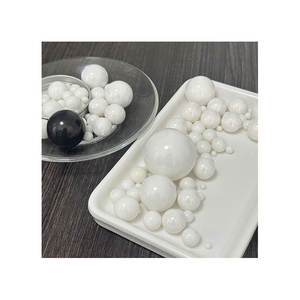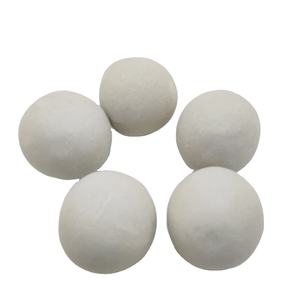1. Material Basics and Microstructural Characteristics
1.1 Structure and Crystallographic Characteristic of Al Two O TWO
(Alumina Ceramic Balls, Alumina Ceramic Balls)
Alumina ceramic rounds are spherical components produced from aluminum oxide (Al two O SIX), a totally oxidized, polycrystalline ceramic that shows outstanding hardness, chemical inertness, and thermal stability.
The main crystalline phase in high-performance alumina rounds is α-alumina, which adopts a corundum-type hexagonal close-packed framework where aluminum ions inhabit two-thirds of the octahedral interstices within an oxygen anion lattice, conferring high latticework energy and resistance to stage makeover.
Industrial-grade alumina balls generally consist of 85% to 99.9% Al ₂ O FOUR, with pureness directly affecting mechanical stamina, put on resistance, and rust performance.
High-purity grades (≥ 95% Al ₂ O TWO) are sintered to near-theoretical thickness (> 99%) utilizing sophisticated strategies such as pressureless sintering or hot isostatic pressing, reducing porosity and intergranular flaws that might serve as anxiety concentrators.
The resulting microstructure includes fine, equiaxed grains evenly distributed throughout the quantity, with grain dimensions typically varying from 1 to 5 micrometers, optimized to balance sturdiness and firmness.
1.2 Mechanical and Physical Property Account
Alumina ceramic spheres are renowned for their severe firmness– measured at roughly 1800– 2000 HV on the Vickers scale– going beyond most steels and measuring up to tungsten carbide, making them perfect for wear-intensive settings.
Their high compressive stamina (approximately 2500 MPa) ensures dimensional stability under tons, while low flexible deformation enhances precision in rolling and grinding applications.
Despite their brittleness relative to metals, alumina balls display excellent crack durability for porcelains, particularly when grain growth is regulated during sintering.
They keep structural integrity throughout a wide temperature level array, from cryogenic problems approximately 1600 ° C in oxidizing environments, much surpassing the thermal limits of polymer or steel equivalents.
Furthermore, their reduced thermal growth coefficient (~ 8 × 10 ⁻⁶/ K) minimizes thermal shock susceptibility, allowing usage in swiftly changing thermal environments such as kilns and warmth exchangers.
2. Manufacturing Processes and Quality Assurance
()
2.1 Shaping and Sintering Strategies
The production of alumina ceramic balls begins with high-purity alumina powder, frequently originated from calcined bauxite or chemically precipitated hydrates, which is milled to accomplish submicron particle size and narrow size distribution.
Powders are then developed right into spherical green bodies making use of approaches such as extrusion-spheronization, spray drying, or ball forming in turning pans, depending upon the wanted size and set range.
After forming, green spheres go through a binder exhaustion stage followed by high-temperature sintering, commonly between 1500 ° C and 1700 ° C, where diffusion mechanisms drive densification and grain coarsening.
Specific control of sintering environment (air or regulated oxygen partial stress), heating rate, and dwell time is essential to achieving uniform shrinkage, round geometry, and minimal interior problems.
For ultra-high-performance applications, post-sintering therapies such as warm isostatic pushing (HIP) may be applied to eliminate residual microporosity and further boost mechanical reliability.
2.2 Precision Finishing and Metrological Confirmation
Complying with sintering, alumina rounds are ground and brightened making use of diamond-impregnated media to accomplish tight dimensional tolerances and surface area coatings equivalent to bearing-grade steel rounds.
Surface roughness is typically lowered to less than 0.05 μm Ra, minimizing rubbing and wear in vibrant contact scenarios.
Critical quality criteria include sphericity (inconsistency from excellent roundness), diameter variant, surface area stability, and density uniformity, every one of which are determined using optical interferometry, coordinate measuring devices (CMM), and laser profilometry.
International standards such as ISO 3290 and ANSI/ABMA specify resistance grades for ceramic balls utilized in bearings, making sure interchangeability and efficiency consistency across producers.
Non-destructive testing techniques like ultrasonic assessment or X-ray microtomography are used to detect interior cracks, voids, or additions that could jeopardize long-lasting integrity.
3. Functional Advantages Over Metal and Polymer Counterparts
3.1 Chemical and Deterioration Resistance in Harsh Environments
One of the most significant benefits of alumina ceramic spheres is their superior resistance to chemical assault.
They continue to be inert in the presence of strong acids (other than hydrofluoric acid), alkalis, natural solvents, and saline solutions, making them ideal for usage in chemical handling, pharmaceutical manufacturing, and aquatic applications where steel parts would wear away swiftly.
This inertness avoids contamination of sensitive media, a vital factor in food processing, semiconductor construction, and biomedical tools.
Unlike steel spheres, alumina does not create rust or metallic ions, making certain process purity and reducing upkeep frequency.
Their non-magnetic nature better expands applicability to MRI-compatible gadgets and electronic production line where magnetic disturbance should be prevented.
3.2 Put On Resistance and Long Service Life
In rough or high-cycle environments, alumina ceramic rounds show wear prices orders of magnitude lower than steel or polymer alternatives.
This extraordinary sturdiness converts into extended service intervals, decreased downtime, and lower complete price of possession regardless of higher first purchase expenses.
They are commonly utilized as grinding media in ball mills for pigment diffusion, mineral processing, and nanomaterial synthesis, where their inertness prevents contamination and their hardness makes sure efficient bit dimension reduction.
In mechanical seals and valve parts, alumina balls keep limited resistances over numerous cycles, standing up to erosion from particulate-laden fluids.
4. Industrial and Arising Applications
4.1 Bearings, Valves, and Liquid Handling Solutions
Alumina ceramic rounds are essential to hybrid sphere bearings, where they are paired with steel or silicon nitride races to combine the reduced thickness and corrosion resistance of porcelains with the toughness of steels.
Their reduced thickness (~ 3.9 g/cm FIVE, concerning 40% lighter than steel) lowers centrifugal packing at high rotational rates, allowing faster procedure with lower heat generation and boosted power performance.
Such bearings are made use of in high-speed spindles, oral handpieces, and aerospace systems where integrity under extreme conditions is extremely important.
In liquid control applications, alumina rounds function as check shutoff components in pumps and metering gadgets, particularly for hostile chemicals, high-purity water, or ultra-high vacuum systems.
Their smooth surface area and dimensional security make certain repeatable securing efficiency and resistance to galling or confiscating.
4.2 Biomedical, Power, and Advanced Modern Technology Uses
Beyond typical commercial duties, alumina ceramic balls are discovering use in biomedical implants and diagnostic equipment because of their biocompatibility and radiolucency.
They are utilized in artificial joints and dental prosthetics where wear particles should be decreased to stop inflammatory responses.
In power systems, they function as inert tracers in storage tank characterization or as heat-stable elements in concentrated solar power and gas cell assemblies.
Research is additionally discovering functionalized alumina balls for catalytic support, sensing unit components, and precision calibration requirements in assessment.
In summary, alumina ceramic spheres exhibit just how sophisticated ceramics link the space in between structural robustness and practical accuracy.
Their one-of-a-kind mix of firmness, chemical inertness, thermal stability, and dimensional precision makes them essential popular design systems across varied fields.
As producing strategies continue to boost, their efficiency and application scope are expected to increase further right into next-generation technologies.
5. Distributor
Advanced Ceramics founded on October 17, 2012, is a high-tech enterprise committed to the research and development, production, processing, sales and technical services of ceramic relative materials such as Alumina Ceramic Balls. Our products includes but not limited to Boron Carbide Ceramic Products, Boron Nitride Ceramic Products, Silicon Carbide Ceramic Products, Silicon Nitride Ceramic Products, Zirconium Dioxide Ceramic Products, etc. If you are interested, please feel free to contact us.(nanotrun@yahoo.com)
Tags: alumina balls,alumina balls,alumina ceramic balls
All articles and pictures are from the Internet. If there are any copyright issues, please contact us in time to delete.
Inquiry us

